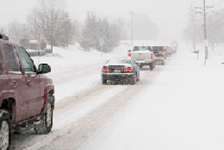
GOOD DRIVING PRACTICES IN ADVERSE CONDITIONS.
* DRIVE SMOOTHLY AND SLOWLY AND SCAN AHEAD;recognise and drive to the conditions especially on snow- and ice-covered roads. Making abrupt starts, stops or turns when driving could cause you to lose control and skid.
* SMOOTH ACCELERATION (Input to gas pedal) going to the Gas pedal quickly will cause the weight to transfer to rear causing front end of vehicle to rise and therefore diminish front wheel traction.
* SMOOTH BRAKING (Input to brake pedal) Heavy braking will cause the weight to transfer to front end of vehicle and dip down and the rear wheels to lift and could cause a rear wheel skid.
*KEEP GOOD SPACE AROUND YOU AS YOU DRIVE: You should have a space cushion to front, rear and both sides of the vehicle.
* INCREASE YOUR FOLLOWING DISTANCE: You should keep a minimum of three (3) seconds when following other vehicles and increase this when the conditions deteriorate.
* KEEP A CAR LENGTH WHEN STOPPED BEHIND OTHER VEHICLES: This will give you ‘an out’ (space) to move into or out off if vehicle in front or behind looks to endanger you (stalled car, possible rear end collision etc.)
* CONTROL OTHER VEHICLES FROM BEHIND: When stopping or slowing down.
* GLANCE IN REAR VIEW MIRROR every time you go to brake or slow down. More than 75 % of two vehicle crashes are rear end collisions.
* SKIDS are caused by over acceleration, over steering and abrupt braking. If your vehicle starts to skid stay off brakes and look where you want your vehicle to go, you will then steer in that direction; better still take a skid control course.
*TRACTION CONTROL does NOT have the ability to increase traction; it just attempts to prevent a vehicle's wheels from spinning. Turn it off if you are stuck in snow and ‘rock’ your vehicle out.
*NEVER USE CRUISE CONTROL if conditions are snowy, icy, or wet, because if your car hydroplanes, your car will try to accelerate, and you may lose control of your vehicle.
*BRIDGES /OVERPASSES AND UNDER PASSEScould be dangerous in the winter because of shaded areas.
*ROADS ARE MORE DANGEROUS when temperatures get close to zero as water can accumulate on top of ice (think of ice cube effect) and could turn into BLACK ICE at night.
* ALWAYS KEEP AN EMERGENCY KIT IN YOUR VEHICLE.
For registered students, see www.progressivedriving.ca under training tips for more information.





